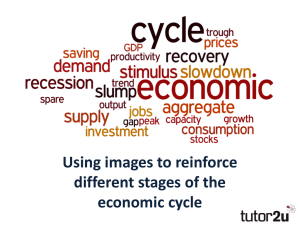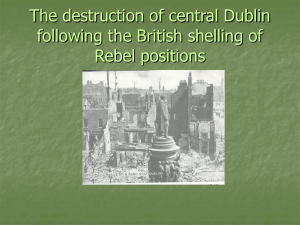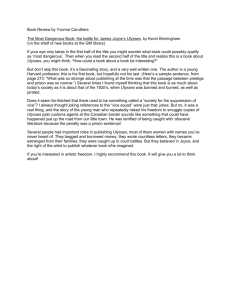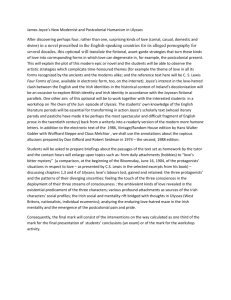Yeats, Joyce and the Easter Rising
advertisement
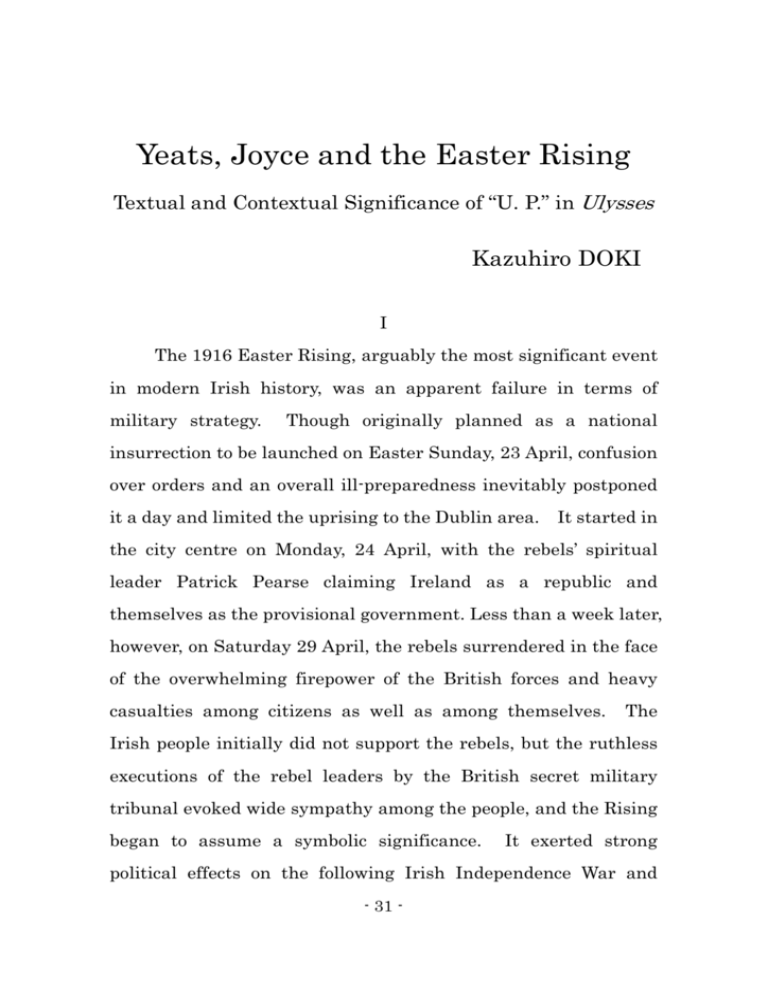
Yeats, Joyce and the Easter Rising Textual and Contextual Significance of “U. P.” in Ulysses Kazuhiro DOKI I The 1916 Easter Rising, arguably the most significant event in modern Irish history, was an apparent failure in terms of military strategy. Though originally planned as a national insurrection to be launched on Easter Sunday, 23 April, confusion over orders and an overall ill-preparedness inevitably postponed it a day and limited the uprising to the Dublin area. It started in the city centre on Monday, 24 April, with the rebels’ spiritual leader Patrick Pearse claiming Ireland as a republic and themselves as the provisional government. Less than a week later, however, on Saturday 29 April, the rebels surrendered in the face of the overwhelming firepower of the British forces and heavy casualties among citizens as well as among themselves. The Irish people initially did not support the rebels, but the ruthless executions of the rebel leaders by the British secret military tribunal evoked wide sympathy among the people, and the Rising began to assume a symbolic significance. It exerted strong political effects on the following Irish Independence War and - 31 - consequently on the establishment of the Irish Free State in 1922. It is well known that the responses of W. B. Yeats (1865-1939) and James Joyce (1882-1941) to this historic upheaval stand in striking contrast to each other: the former is timely and direct while the latter is silence. Joyce, however, wrote in a letter that his art should be the most suitable means to delineate the matter (Manganiello, 162), and there has been some critical agreement that certain scenes in Ulysses can be read as allusions to the devastation of the Easter Rising. There is no doubt that Joyce was no less concerned with the aesthetic representation of the Rising than Yeats and his attitude no less complicated. In this paper, I would like to offer an overview of the critical arguments on this subject and then explore the textual and contextual dimensions of the Rising registered in Ulysses by focusing attention on the postcard sent to Denis Breen on which the mysterious word “U. P.” is written. II Yeats completed “Easter 1916,” his most famous political poem, five months after the Rising. Its memorable refrain, “A terrible beauty is born,” eloquently shows the poet’s mixed feeling towards the uprising. Helen Vendler has suggested that although Yeats “wanted to praise the rebels’ bravery, their love of Ireland, and their faith in proclaiming a Republic that did not yet - 32 - exist,” he could not accept their armed violence (17). In light of the fact that the Bill for creating Home Rule for Ireland had been already passed by Westminster in 1913, albeit suspended due to the outbreak of the First World War, the “I” narrator in the poem asks himself whether the death of those who were involved in the Rising was “needless.” Instead of answering the question, however, the narrator just mentions the names of the dead and predicts their eternal glory as national heroes: MacDonagh and MacBride And Connolly and Pearse Now and in time to be, Wherever green is worn, Are changed, changed utterly: A terrible beauty is born. This prediction of the martyrs’ eternal glory echoes the ending of his 1902 one-act play “Cathleen ni Houlihan.” In the play, an old woman who represents Ireland recruits young men for the purpose of recovering her lost lands; responding to her call, the young protagonist leaves his fiancée in order to join the French army and fight for Irish independence. Again, Yeats was embarrassed by the probability that the play might have been a - 33 - remote cause of the Rising. In fact, it is said that Pearse had been inspired by the drama and had come up with his belief in the Rising as a “blood sacrifice.” According to David Lloyd, the “Blood sacrifice” or martyrdom realized in the name of Ireland caused Yeats dual anxiety: the displacement of the poet as a symbolic identity, as well as of a visionary for the future nation, and the poetic rupture between the sublime and the beautiful. The traditional role of the poet in terms of Irish cultural nationalism has been to represent the nation to be realized and work to mediate its realization. The rebels displaced the poet from this role, substituting violence for poetry. Thus, in the poem, Yeats inevitably assumes the passive or secondary role of a mother who is only to murmur the names of the dead. The poetic rupture between the sublime and the beautiful precisely represents the discontinuity in history caused by the violence of the Rising: Both cultural and militant nationalism appeal to a version of the sublime, seeking to transcend death even in death by identifying with the greater life of the nation they are producing. The actual foundation of the nation spells the end of this horizon of transcendence, as it spells an end to the developmental desire - 34 - of cultural nationalism, absorbing terror into the heretofore feminine sphere of rememorative reproduction. (Lloyd, 73) Once the nation is established, the poet who advocated it loses his actual role along with the nationalist narrative with which he identifies himself. The realm of the sublime ends and that of the beautiful, namely, everyday life of the citizen begins. Yet the violence which gave birth to the nation, namely the terrible, haunts it as “a stone / To trouble the living stream.” The ambiguity of the phrase “A terrible beauty is born” eloquently reflects this anxiety of Yeats. III Contrary to Yeats, Joyce did not make any direct reference to the Rising, either in his novels or in his critical writings. Ellmann’s biography registers Joyce’s rejection of an invitation to write an analysis of the Rising for a Swiss journal. Yet, as I have mentioned above, Joyce revealed in a letter his intention to represent the Rising by means of his art. Hugh Kenner is one of the earliest critics who addressed this problem. He says: “A dark tavern dominated by a mad fool is Joyce’s synecdoche for the state of Irish patriotism twelve years before the rebellion” (Ulysses, 93). Kenner suggests that the ‘Cyclops’ episode foreshadows the foolishness of the Rising, but faced with Joyce’s reticence, quotes - 35 - Yeats’ father: “Ireland would have pitied and loved and smiled at these men, knowing them to be fools.” On the other hand, James Fairhall’s analysis reads Stephen smashing a chandelier in a brothel in the ‘Circe’ episode as an allusion to the Rising, and his violent encounter with British soldiers that follows as an allusion to the Civil War of 1922-23 (47). Emer Nolan has further developed the potential of the ‘Circe’ episode to be seen as a cultural representation of the Easter Rising. She points out the fact that the Rising itself failed in reaching out to the ordinary citizen of Dublin, calling it a bourgeois revolution (133). Thus, the farcical and carnivalesque façade of the episode symbolically reflects that of the Rising. Enda Duffy calls attention to the timing of the Rising as it “occurred in the same year that Joyce was writing some of his most evocative passages on ‘Wandering Rocks’ episode” (37). Dublin streetscapes, in the The streets and buildings Joyce was depicting in his novel were being shelled and demolished at the same time in Dublin. This surrealistic situation, she argues, paradoxically offered Joyce a creative inspiration and thus Ulysses began to assume a unique characteristic: Ulysses contrasts a busy mimeticism about specific details on the one hand with a relentless strategy of omitting most of Dublin from the novel on the other. Thus the space - 36 - represented is at once uncannily hyperrealized in parts and ignored in others. The cornucopia of details is counterpoised with an equally eloquent missing Ulysses. (46) Duffy summarizes this characteristic as “a late colonial milieu where the spatial real is never simply what it appears” (46). IV After having briefly summarized critical arguments on how Ulysses represents the Easter Rising, however, we notice that critics seem more interested in pointing out adequacy or inadequacy of mimetic representation than in a close analysis of the text and language. As Fairhall and Nolan suggest, the smashed chandelier scene may be an allusion to the havoc of the Rising, but it appears more as a superficial representation without textual and linguistic elaboration. Duffy’s argument that the Rising had convinced Joyce of the inadequacy of literary mimesis should be valid, but Joyce must have been aware of this long before the Rising. Also, in spite of the sophistication of her theory, Duffy does not demonstrate any specific textual and linguistic analysis to endorse it. Given that Joyce is known as a manipulator of language, the question of how he refers to the Rising should be addressed not simply from the mimetic level, but - 37 - also the textual and linguistic. To set about this task, I would like to choose one of the well-known Joycean conundrums in Ulysses, namely, the anonymous postcard sent to Denis Breen, on which the mysterious initials “U.P.” are written. Bloom is shown the card for the first time by Breen’s wife: [Mrs Breen] took a folded postcard from her handbag. ― Read that, she said. He got it this morning. ― What is it? Mr Bloom asked, taking the card. U. P.? ― U. p: up, she said. Someone taking a rise out of him. It’s great shame for them whoever he is. (8. 255-59) According to Partridge’s Dictionary of Slang, U. P. means “finished” or “remediless,” so “ ‘ ’tis up with him’ is said of a poor fellow who may not have a leg to stand upon.” Also, according to Gifford’s Annotation, the phrase is used by an apothecary in Dickens’ Oliver Twist to refer to a person whose end is approaching. In Ulysses, Breen takes the postcard as personal slander and wants to start a lawsuit against it. His fellow Dubliners do not miss this rare opportunity for entertainment, thinking that he is insane, possibly, another connotation of the word “U. P.” In fact, Breen’s wife worries that her husband will be “dotty,” meaning “mad,” one of these days. - 38 - As a result, Breen becomes an ideal pub joke: ― Look at him, says [Bergan]. Breen. He’s traipsing all round Dublin with a postcard someone sent him with U. p: up on it to take a li … And he doubled up. ― Take a what? says I. ― Libel action, says he, for ten thousand pounds. — O hell! says I. The bloody mongrel began to growl that’d put the fear of God in you seeing something was up but the citizen gave him a kick in the ribs. (12. 257-64) There is a rumor that this laughing man, Alfred Bergan, must be the very person who has sent the anonymous postcard to Breen. But since the reader is never given any decisive clue on this matter, it remains one of the unsolvable enigmas of the text. I would like to suggest that a passage from “Wandering Rocks” episode provides a helpful clue to understanding this enigma: Where the foreleg of King Billy’s horse pawed the air Mrs Breen plucked her hastening husband back from under the hoofs of the outriders. She shouted in his ear the - 39 - tidings. Understanding, he shifted his tomes to his left breast and saluted the second carriage. (10. 1231- 35) Here, Breen tries to cross the street at the statue of King William III, as the cavalcade of the viceroy approaches and almost runs him over. Needless to say, William III, who defeated James II in the Battle of the Boyne 1689 and paved the way for Protestant Ascendancy, is a symbolic figure for the final stage of the English colonization of Ireland. Therefore, he marks one end of the history, while the viceroy marks the other. Breen, who is closed in from both sides with their horses’ “hoofs,” can be seen as an allegorical figure of colonial Ireland at the turn of the century, or in Joycean terms, as a picture of paralysis. If so, the U.P. postcard sent to Breen can be interpreted as a secret message or appeal not only to Breen but also to all Dubliners to wake up from the paralysis. Incidentally, while Breen is called “that bloody old pantaloon” by the anonymous narrator in Barney Kiernan’s pub (12. 253), Yeats describes the pre-Rising Dublin as a place “where motley is worn” in “Easter 1916.” Considering their great differences in literary style and political stance, this similarity in rhetoric appears quite remarkable. Both Yeats and Joyce visualized Dublin at that time as a place for comedies, where people could not see or reject to see their own reality. Again, Breen allegorically represents - 40 - this situation, as he cannot grasp the reason of his predicament and exhausts himself in the unrealistic lawsuit. Considering the text-context relationship at that time, I suggest that U. P. should also be interpreted as an allusion to the Easter Rising itself. “Up” can be short for “Up in arms.” Actually, the “libel action” Breen wants to take is only a step away from a “rebel action” in interchangeable. Joycean idiom and they seem to be If so, Breen’s unrealistic lawsuit could be a conundrum for the Rising as it too appeared unrealistic to most Dubliners at that time. Interestingly, in the above quotation from the Barney Kiernan’s pub scene, the “bloody” mongrel begins to growl as it sees something is “up.” It is well known that the citizen, the owner of the dog, is modeled on Michael Cusack, the founder of the Gaelic Athletic Association, possibly a sympathizer of the Easter Rising. Even though the citizen kicks the “bloody” mongrel to curb its attack, it seems most suitable to see the brutal pair as a caricature of those who were “Up in arms.” Of course, Joyce was clearly against the violence of the Rising even though he wanted people in Dublin to wake up from their paralysis. The rising “Up in arms” actually carried out by Patrick Pearce and his followers in the center of Dublin appeared as utter madness to the exiled author and Mrs. Breen who predicts that her husband will be mad before long may reflect the author’s concern. The postcard addressed to Denis Breen thus - 41 - functions as a unique narrative technique to smuggle various levels of Joyce’s “voice” into the text. While Yeats expressed his anxiety over the Rising in the phrase of “terrible beauty,” Joyce, in the assumed silence, registered his harsh criticism to the Rising in the multilayered text of Ulysses. V In the “Cyclops” episode, people gather in Barney Kiernan’s pub to talk about how Joe Brady, allegedly the chief assassin of the Phoenix Park murders, was hanged in the prison of Kilmainham: ― God’s truth, says Alf. I heard that from the head warder that was in Kilmainham when they hanged Joe Brady, the invincible. He told me when they cut him down after the drop it was standing up in their faces like a poker. (Ulysses, 12. 459-62) The Phoenix Park murders form a legendary plot for Irish nationalists; they were carried out by a group called the Invincibles on 6 May 1882. Two British high officials, Lord Cavendish and Thomas Burke, were murdered and five assassins including Brady were hanged. Fairhall points out that the executions “aroused much sympathy for the victims and - 42 - indignation against the authorities” and “transformed [the victims] from villains into nationalist heroes,” which foreshadowed “the aftermath of the Easter 1916 Rising” (13). Given that Joyce wrote this passage around 1919, about three years after the Rising, it is most probable that he planned it as a deliberate allusion to the fate of the Rising leaders. As a historical fact, most of the leaders were shot by a firing squad; Roger Casement was hanged in London. Yet the standing male organ of the hanged nationalist-terrorist should be read as an ultimate Joycean metaphor of the Easter Rising. To the author, using violence against violence, or phallus against phallus, was nothing but the “nightmare” from which we as well as his compatriots should wake up. This paper has developed from an earlier version with the same title presented at the 2010 ELLAK International Conference in Daejeon, South Korea. - 43 - References Primary Texts Jeffares A. Norman, ed. Poems of W. B. Yeats: A New Selection. London: Macmillan, 1984. Joyce, James. Ulysses. Ed. Hans Walter Gabler, et. al. London: The Bodley Head, 1986. Works Cited Duffy, Enda. “Disappearing Dublin: Ulysses, postcoloniality, and the politics of space.” Semicolonial Joyce. Cambridge: Cambridge University Press, 2000, 37-57. Fairhall, James. James Joyce and the Question of History. Cambridge: Cambridge University Press, 1993. Kenner, Hugh. Ulysses. London: George Allen & Unwin, 1982. Lloyd, David. Anomalous States: Irish Writing and the Post-Colonial Moment. Durham: Duke University Press, 1993. Manganiello, Dominic. Joyce’s Politics. London: Routledge & Kegan Paul, 1980. Nolan, Emer. James Joyce and Nationalism. London: Routledge, 1995. Vendler, Helen. Our Secret Discipline: Yeats and Lyric Form. Massachusetts: The Belknap Press of Harvard University Press, 2007. - 44 -
